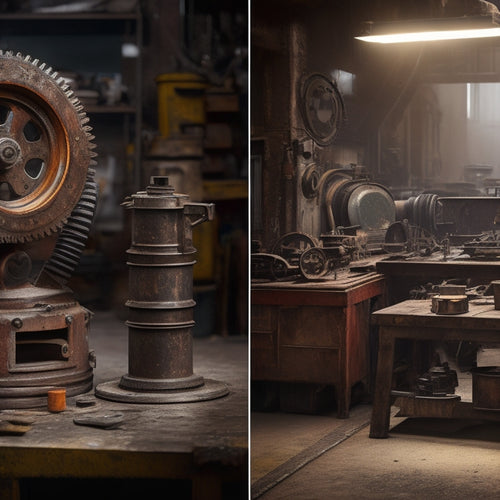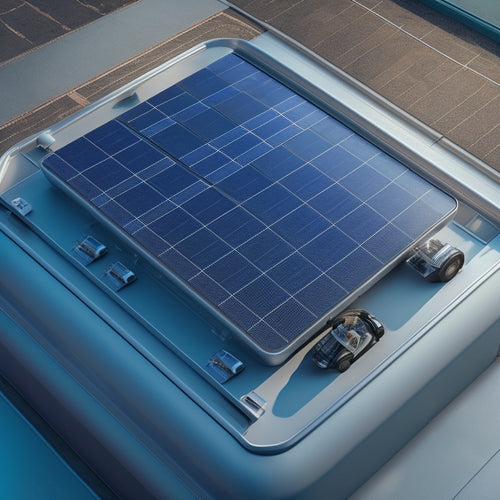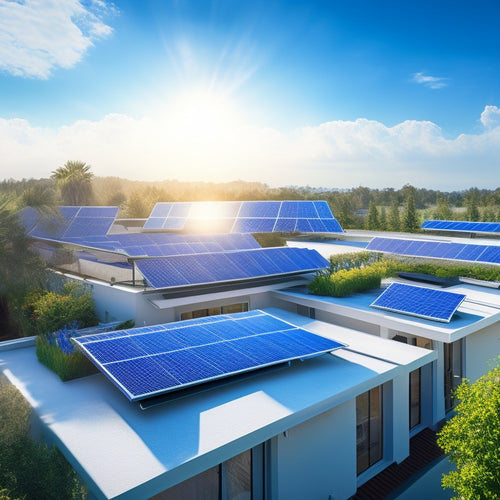
Factors That Influence the Cost of Solar Installation for a Home
Share
As you contemplate shifting to solar energy, you'll find that the cost of installation is influenced by a range of factors, from the size and quality of your solar panel system to the condition of your roof and the local building codes and permits required. Your energy needs, panel efficiency, and inverter technology all impact upfront costs and long-term savings. You'll also need to take into account factors like battery backup and storage options, installation company and labor costs, and state and federal incentives that can offset expenses. As you investigate these factors, you'll uncover the specific considerations that will drive your solar installation costs, and a clearer image of your investment will emerge.
Key Takeaways
- System size, quality, and efficiency impact overall cost, with larger systems providing greater long-term electricity savings.
- Installation company selection, labor rates, and workforce availability affect the final cost of solar installation.
- Roof size, condition, and orientation influence the installation process, with larger roofs allowing for more panels and optimal performance.
- Local building codes, permits, and regulatory incentives can significantly reduce or increase the upfront cost of solar installations.
- Financing options, such as federal tax credits, state rebates, and low-interest loans, can offset energy storage costs and make solar investments more affordable.
System Size and Quality
When it comes to solar installation, the system size and quality are vital factors that greatly impact the overall cost. You'll want to take into account the size of your system, measured in watts (W), which depends on your energy usage and available roof space. A larger system means more panels, which increases the upfront cost.
However, it can also lead to greater electricity savings in the long run.
The quality of your solar panel types is another significant aspect to take into account. High-efficiency panels may be more expensive, but they can generate more power per hour of sunlight.
Additionally, the inverter technology you choose can affect your system's performance and cost. String inverters are the most common type, but microinverters and power optimizers offer more flexibility and monitoring capabilities, albeit at a higher cost.
Be sure to weigh the pros and cons of each option to find the best balance of quality and affordability for your solar installation. By making informed decisions about system size and quality, you can guarantee a successful and cost-effective shift to renewable energy.
Installation Company and Labor
The installation company and labor costs constitute a significant portion of your overall solar installation expense. When selecting an installation company, you'll want to evaluate their experience, labor rates, and workforce availability. A reputable company with a skilled workforce will guarantee a smooth installation process.
Look for companies that invest in training programs, adhere to strict safety standards, and have a proven track record of meeting installation timelines.
The size of the crew and project management style can also impact labor costs. A well-managed project with an efficient crew size can reduce labor hours and costs.
Additionally, assess the role of subcontractors and how they fit into the installation process. Be wary of companies that heavily rely on subcontractors, as this can increase costs and reduce accountability.
Roof Size and Condition
When you're considering a solar installation, you'll need to assess your roof's size and condition.
A larger roof provides more space for solar panels, which can increase energy output, but may also require more materials and labor, adding to the overall cost.
If your roof is damaged or in disrepair, you'll need to factor in the cost of repairs or replacement before installing solar panels.
Roof Size Matters
You'll likely find that your roof's size and condition play a significant role in determining the cost of your solar installation. A larger roof requires more solar panels, which increases the overall cost. Additionally, the condition of your roof affects the installation process. A roof in good condition allows for a faster and more efficient installation, reducing labor costs.
| Roof Characteristics | Impact on Cost |
|---|---|
| Larger roof size | Increases cost due to more panels needed |
| Complex roof layout | Increases cost due to additional installation complexity |
| South-facing roof orientation | Optimizes solar panel performance, reducing cost |
| Shading from trees or structures | Requires additional shading analysis, increasing cost |
When it comes to your roof's condition, the timing of your installation also matters. If you're planning to replace your roof soon, it may be more cost-effective to do so before installing solar panels. This guarantees that your new roof is compatible with your solar panel system, reducing the need for future repairs or replacements. Considering these factors will help you better understand the cost of your solar installation and make informed decisions about your project.
Roof Damage and Repair
Since your roof's condition plays a significant role in determining the cost of your solar installation, it's important to assess its current state before moving forward with the project.
If you have roof leaks or structural integrity issues, repairs will be necessary before installing solar panels. This can add to the overall cost, but it's vital to guarantee the safety and longevity of your solar system.
The type of roofing materials you have will also impact the installation timing and cost. For instance, if you have a complex or fragile roof, installation may take longer and require more labor.
Be sure to review your warranty coverage and insurance considerations, as some policies may cover roof repairs or replacements related to solar installation.
Additionally, consider the aesthetic impact of solar panels on your roof's appearance and how they'll affect ventilation issues, especially in climates with high winds or heavy snowfall.
Proper installation and orientation of solar panels will also mitigate climate impact and guarantee peak energy production.
Local Building Codes and Permits
Local building codes and permits play a critical role in guaranteeing that your solar installation meets the necessary safety and quality standards. These regulations vary by region, and it's important to understand how they impact your project.
-
Zoning regulations: Confirm your solar installation complies with local zoning laws, which dictate the size, location, and type of solar panels allowed on your property.
-
Inspection requirements: You'll need to schedule inspections with local authorities to verify that your installation meets safety standards and building codes. This may add to your overall cost and installation timeline.
-
Permit fees: You'll need to pay fees for the necessary permits, which can range from a few hundred to several thousand dollars, depending on your location and the complexity of your project.
Understanding these local requirements will help you budget accordingly and avoid potential delays or fines.
Additionally, some local governments offer incentives for solar installations, such as tax credits or rebates, which can help offset the costs. Be sure to research these opportunities to maximize your savings.
Energy Efficiency and Output
Energy Efficiency and Output
When evaluating solar installation for your home, it's vital to think about energy efficiency and output. You want to maximize your energy output to reduce your environmental impact and enjoy long-term savings.
Solar panel efficiency plays a significant role in this. High-efficiency panels can generate more power per hour of sunlight, resulting in greater energy output optimization. With advancements in solar technology, you can expect more efficient panels that produce more energy.
To get the most out of your solar installation, it's important to assess installation timing and financing options. Proper installation and maintenance can guarantee your system operates at its best, providing you with grid independence and significant savings.
Additionally, look for system warranties that assure a certain level of energy output. As a homeowner, it's vital to educate yourself on how to optimize your energy output, and a reputable installer can provide guidance on this.
Battery Backup and Storage
You're likely considering battery backup and storage options to guarantee a steady power supply when the grid is down or during periods of high energy demand.
You'll need to choose between various energy storage options, including lead-acid, lithium-ion, and flow batteries, each with its own advantages and limitations.
Energy Storage Options
One key aspect of guaranteeing a reliable and efficient solar installation is incorporating energy storage options. This allows you to store excess energy generated by your solar panels during the day for use at night or during power outages.
When evaluating energy storage options, you'll want to think about the following:
-
Battery Lifespan: How long will your batteries last, and what kind of maintenance will they require?
-
System Compatibility: Will your energy storage system work seamlessly with your existing solar panel setup and grid connection?
-
Financing Options: Are there financing options available to help offset the cost of energy storage, and what're the long-term benefits of investing in this technology?
As you investigate energy storage options, you'll want to reflect on the environmental impact of your choices, as well as the potential for energy independence.
With technology advancements, energy storage is becoming more efficient and cost-effective, making it a worthwhile investment for homeowners.
Backup Power Systems
Backup power systems, comprising battery backup and storage, play an essential role in guaranteeing your solar installation remains operational during grid outages or nighttime hours.
These systems allow you to store excess energy generated by your solar panel types during the day for later use, providing a reliable source of power when the grid is down.
The cost of backup power systems varies depending on the type and size of the battery storage system you choose.
Generally, a larger battery capacity will result in a higher upfront cost. However, it also means you'll have more power available during outages.
Inverter efficiency also plays a significant role in determining the overall cost of your backup power system. A high-efficiency inverter will convert more of the DC power from your solar panels to AC power for your home, reducing energy losses and increasing the overall efficiency of your system.
When selecting a backup power system, consider your energy needs during outages and the duration you need to power your home.
Off-Grid Capabilities
Considering your energy needs during outages, a backup power system can provide a reliable source of power.
With off-grid capabilities, you can enjoy solar autonomy and energy independence. This means you can still power your home even when the grid is down.
Off-grid capabilities come with additional costs, but they offer several benefits:
-
Increased energy independence: You're no longer reliant on the grid for power, giving you more control over your energy needs.
-
Improved reliability: With a battery backup system, you can guarantee continuous power supply during outages or natural disasters.
-
Enhanced safety: Off-grid capabilities can provide power for critical systems like medical equipment, refrigeration, and lighting during extended outages.
When considering off-grid capabilities, you'll need to factor in the cost of battery storage, inverters, and other necessary equipment.
The type and size of your system will depend on your energy needs and budget.
State and Federal Incentives
Your investment in solar energy can greatly benefit from state and federal incentives, which can help offset the upfront cost of solar installation.
As you consider going solar, you'll want to investigate the various incentives available to you. Federal tax credits, for instance, can provide a significant reduction in your tax liability.
Additionally, many states offer rebate programs that can help cover a portion of the installation cost. You may also have access to special financing options, such as low-interest loans or property-assessed clean energy (PACE) financing, which can make it easier to afford the initial investment.
Monitoring and Maintenance Costs
One essential aspect of owning a solar installation is understanding the ongoing monitoring and maintenance costs.
You'll want to evaluate the expenses associated with guaranteeing your system operates at peak performance.
Here are three key factors to evaluate:
-
Monitoring technology and frequency: The type of monitoring technology used and how often your system is monitored can impact costs. Remote monitoring can be more cost-effective than on-site visits.
-
Maintenance frequency and type: The frequency and type of maintenance required will influence costs. Preventive care, such as regular cleaning, can help reduce the need for costly repairs.
-
Service contracts and warranty coverage: Having a service contract in place can provide cost savings and peace of mind. Warranty coverage can also protect you from unexpected expenses.
When selecting a solar installer, look for one that provides thorough installation training and offers software updates to guarantee your system stays optimized.
Frequently Asked Questions
Can I Install Solar Panels on a Rented Property?
You can install solar panels on a rented property, but you'll need to negotiate renter agreements with your landlord, considering installation options like roof leases or community solar programs that benefit both you and the property owner.
How Long Does a Typical Solar Installation Take?
As you commence this eco-friendly expedition, you'll find that a typical solar installation takes around 3-5 days, but be prepared for a longer installation timeline if your project complexity is high, requiring more labor and materials.
Are Solar Panels Compatible With All Roof Types?
You'll find that solar panels are compatible with most roof types, but you'll face installation challenges with certain roof materials, such as slate, clay, or asbestos, which may require specialized equipment or labor, increasing the overall cost.
Can I Sell Excess Energy Back to the Grid?
Imagine a superhero cape flowing behind you, powered by excess energy! You can sell it back to the grid through net metering, earning energy credits that offset your bill, thanks to beneficial policies that put cash back in your pocket.
Do Solar Panels Require Frequent Cleaning?
You'll be relieved to know that solar panels don't require frequent cleaning, as they're designed to operate efficiently with minimal maintenance; however, occasional cleaning is necessary to guarantee peak energy output, making regular solar panel maintenance a must.
Conclusion
As you weigh the cost of solar installation for your home, remember that it's like maneuvering through a puzzle - every piece matters. Just as a single misaligned piece can throw off the entire image, each factor, from system size to local building codes, can impact the final cost. For instance, a 2019 report found that homes with high-efficiency solar panels saw a 10% increase in property value. By understanding these factors, you can create a clear image of your solar installation costs and make an informed decision.
Related Posts
-

Why Higher Upfront Costs Are Worth It
You pay a premium for high-quality, energy-efficient products, but they're worth it. With durability testing ensuring...
-

Top Solar Panels for Car Battery Maintenance
When selecting top solar panels for car battery maintenance, consider high-efficiency models with high wattage output...
-

Best Solar Panel Options for Maximum Energy Savings
You can maximize your energy savings with solar panels that boast efficiency ratings above 20%, paired with extensive...


